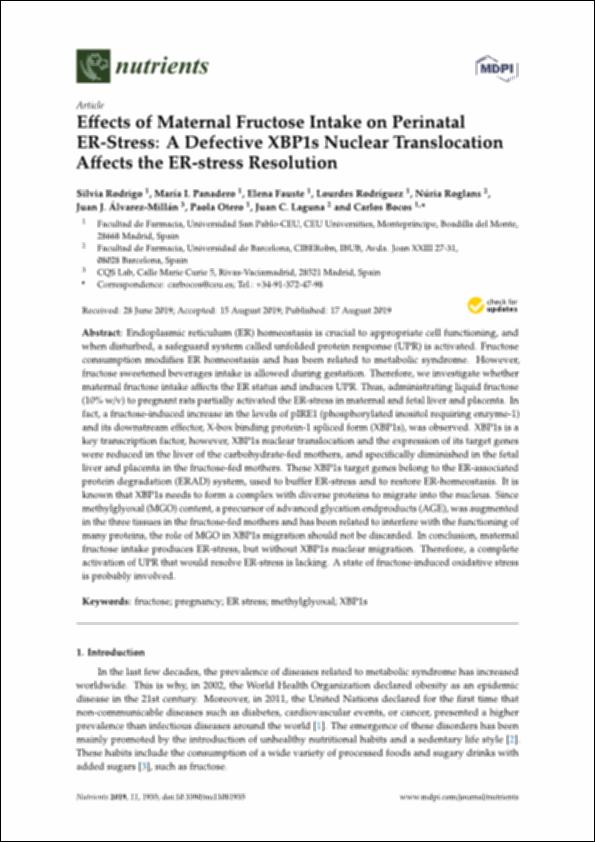Please use this identifier to cite or link to this item:
http://hdl.handle.net/10637/12941Effects of maternal fructose intake on perinatal ER-stress: a defective XBP1s nuclear translocation affects the ER-stress resolution.
| Title: | Effects of maternal fructose intake on perinatal ER-stress: a defective XBP1s nuclear translocation affects the ER-stress resolution. |
| Authors : | Rodríguez, Lourdes Bocos de Prada, Carlos Panadero Antón, María Isabel Rodrigo, Silvia Fauste Alonso, Elena Roglans, Nuria Álvarez Millán, Juan José Otero Gómez, Paola Laguna de Paz, José Carlos |
| Keywords: | Fructose.; Pregnancy.; ER stress.; Methylglyoxal.; XBP1s. |
| Abstract: | Endoplasmic reticulum (ER) homeostasis is crucial to appropriate cell functioning, and when disturbed, a safeguard system called unfolded protein response (UPR) is activated. Fructose consumption modifies ER homeostasis and has been related to metabolic syndrome. However, fructose sweetened beverages intake is allowed during gestation. Therefore, we investigate whether maternal fructose intake affects the ER status and induces UPR. Thus, administrating liquid fructose (10% w/v) to pregnant rats partially activated the ER-stress in maternal and fetal liver and placenta. In fact, a fructose-induced increase in the levels of pIRE1 (phosphorylated inositol requiring enzyme-1) and its downstream effector, X-box binding protein-1 spliced form (XBP1s), was observed. XBP1s is a key transcription factor, however, XBP1s nuclear translocation and the expression of its target genes were reduced in the liver of the carbohydrate-fed mothers, and specifically diminished in the fetal liver and placenta in the fructose-fed mothers. These XBP1s target genes belong to the ER-associated protein degradation (ERAD) system, used to buffer ER-stress and to restore ER-homeostasis. It is known that XBP1s needs to form a complex with diverse proteins to migrate into the nucleus. Since methylglyoxal (MGO) content, a precursor of advanced glycation endproducts (AGE), was augmented in the three tissues in the fructose-fed mothers and has been related to interfere with the functioning of many proteins, the role of MGO in XBP1s migration should not be discarded. In conclusion, maternal fructose intake produces ER-stress, but without XBP1s nuclear migration. Therefore, a complete activation of UPR that would resolve ER-stress is lacking. A state of fructose-induced oxidative stress is probably involved. |
| Description: | Artículo en colaboración: María I. Panadero, Elena Fauste, Lourdes Rodríguez, Núria Roglans, Juan J. Álvarez-Millán, Paola Otero, Juan C. Laguna and Carlos Bocos En: Nutrients. 2019. vol. 11 (8) : 1935. e-ISSN 2072-6643 |
| URI: | http://hdl.handle.net/10637/12941 |
| Rights : | http://creativecommons.org/licenses/by-nc-nd/4.0/deed.es |
| Issue Date: | 10-Aug-2019 |
| Center : | Universidad San Pablo-CEU |
| Appears in Collections: | Facultad de Farmacia |
Items in DSpace are protected by copyright, with all rights reserved, unless otherwise indicated.


